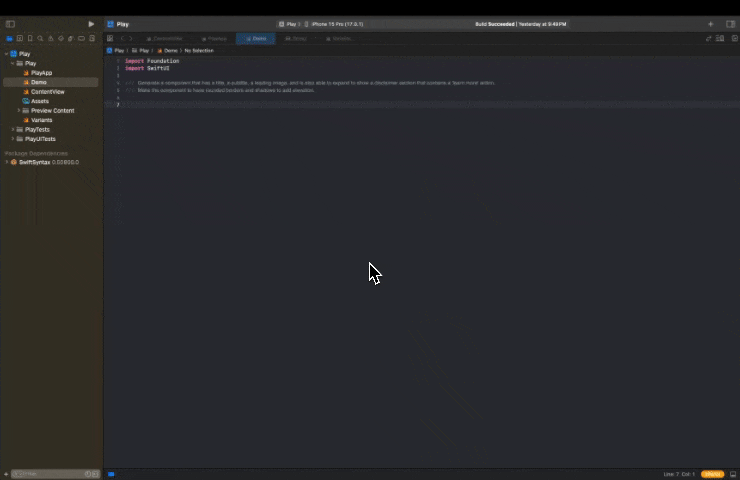Time flies, and before we know it, it’s already the end of March, with just over two months left until WWDC 2024. Recently, some developers have started listing the new features and functionalities they hope to see at WWDC 2024. Every developer within the Apple ecosystem has their own hopes and expectations, what are you looking forward to? Feel free to share your wishlist via Twitter or comment, and I plan to feature these wishlists in one of the May editions of the newsletter.
Since launching the first edition of “Fatbobman’s Swift Weekly” on October 9, 2023, the next issue marks a half-year milestone (taking into account a break for the Spring Festival). Currently, the newsletter reaches its audience through multiple platforms, including email, WeChat official account, Medium, Zhihu, and Juejin. Email subscribers have surpassed 1,300, with an opening rate steady at nearly 60%. These numbers, especially the email subscription count, have far exceeded my expectations and have greatly motivated me. I hope to reach 3,000 email subscribers by the end of 2024. If you haven’t subscribed to the email version yet, please help me achieve this goal.
Next week, I will be attending the Let’s VisionOS 2024 event in Beijing, where I’ll share some insights on SwiftData and Observation. I’m also looking forward to engaging in face-to-face discussions with more friends at the event.
Originals
Practical SwiftData: Building SwiftUI Applications with Modern Approaches
In the previous article Concurrent Programming in SwiftData, we delved into the innovative concurrent programming model proposed by SwiftData, including its principles, core operations, and related considerations. This elegant programming solution has earned considerable praise. However, as more developers attempt to use SwiftData in actual SwiftUI applications, they have encountered some challenges, especially after enabling Swift’s strict concurrency checks. They found that SwiftData’s actor-based concurrency model is difficult to integrate with traditional application construction methods. This article will explain, in a tutorial-like manner, how to integrate SwiftData with modern programming concepts smoothly into SwiftUI applications and provide strategies to address the current challenges faced by developers.
Recent Selections
Building an ML App with SwiftUI (Part 1)
While Apple is still catching up in the generative AI field, it has already provided developers with mature native AI model solutions. DanielJia plans to showcase, through a series of articles, how to start from scratch to train a machine learning model and integrate it into iOS app development, with a strong emphasis on compatibility with SwiftUI. This article uses the YOLO model as an example, explaining the preparation of data, downloading and processing of datasets, and setting up the training environment for the model. It aims to provide iOS developers with a clear guide to developing machine learning applications.
Prompt to code in Xcode with Claude 3
Although there are rumors that Apple plans to introduce AI capabilities to Xcode this year, many developers are already eagerly integrating various AI services into their development workflow. In this article, James Rochabrun shows us how to develop an Xcode plugin that leverages Anthropic’s latest language model, Claude 3, to provide assistance similar to Copilot. A highlight of the article is how to write effective prompts, which is crucial for generating precise code outputs. The image below displays the final implementation.

Oh Sh*t, My App is Successful and I Didn’t Think About Accessibility
Accessibility design can benefit a broader range of users, but due to cost and resource constraints, projects that fully consider accessibility throughout the development process are not common. In this article, Jacob Bartlett delves into the importance of implementing accessibility design in SwiftUI applications and demonstrates through practical examples how to apply accessibility development techniques at different stages of a SwiftUI project. He emphasizes that once developers have mastered these accessibility strategies, they should integrate these practices into their standard development workflow to prevent potential future issues. The article not only provides detailed technical guidance but also highlights developers’ social responsibility, reminding them that in their pursuit of application success, they should not overlook those users who rely on accessibility features.
Sending Trial Notifications with Provisional Authorization on iOS
Apple’s notification framework includes a provisional notification feature, allowing applications to silently send notifications to the Notification Center without direct permission from the user. This strategy cleverly guides users to a preliminary understanding of the app’s notification capabilities. In this article, Natalia Panferova elaborates on how to effectively utilize this feature. She believes that implementing provisional notifications is an excellent strategy that can demonstrate the value of staying connected through the app while respecting user preferences. However, developers must ensure the usefulness, timeliness, and respect for user choices when implementing various notifications.
Getting Started with Structured Concurrency in Swift
Through structured concurrency, developers can effectively manage concurrent tasks, reducing common concurrency programming challenges such as race conditions and deadlocks. With the development of Swift 6, developers are expected to fully transition to adopting structured concurrency as their development paradigm. In this article, Joannis Orlandos introduces how to apply task groups and other structured concepts in applications to write more maintainable and comprehensible concurrent code. He also plans to explore Swift’s actor model in future articles, as well as how to use this model to write code free from race conditions.
